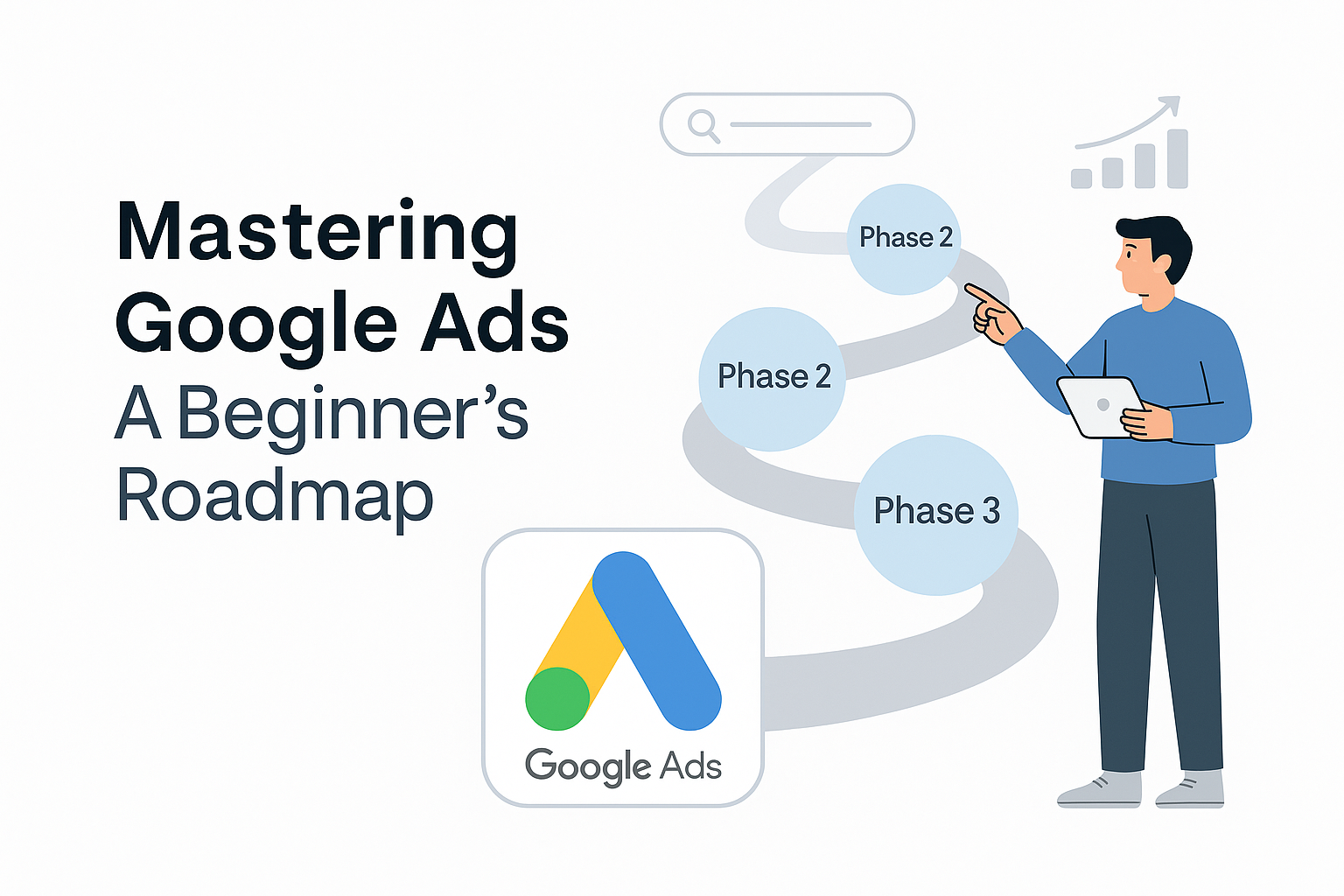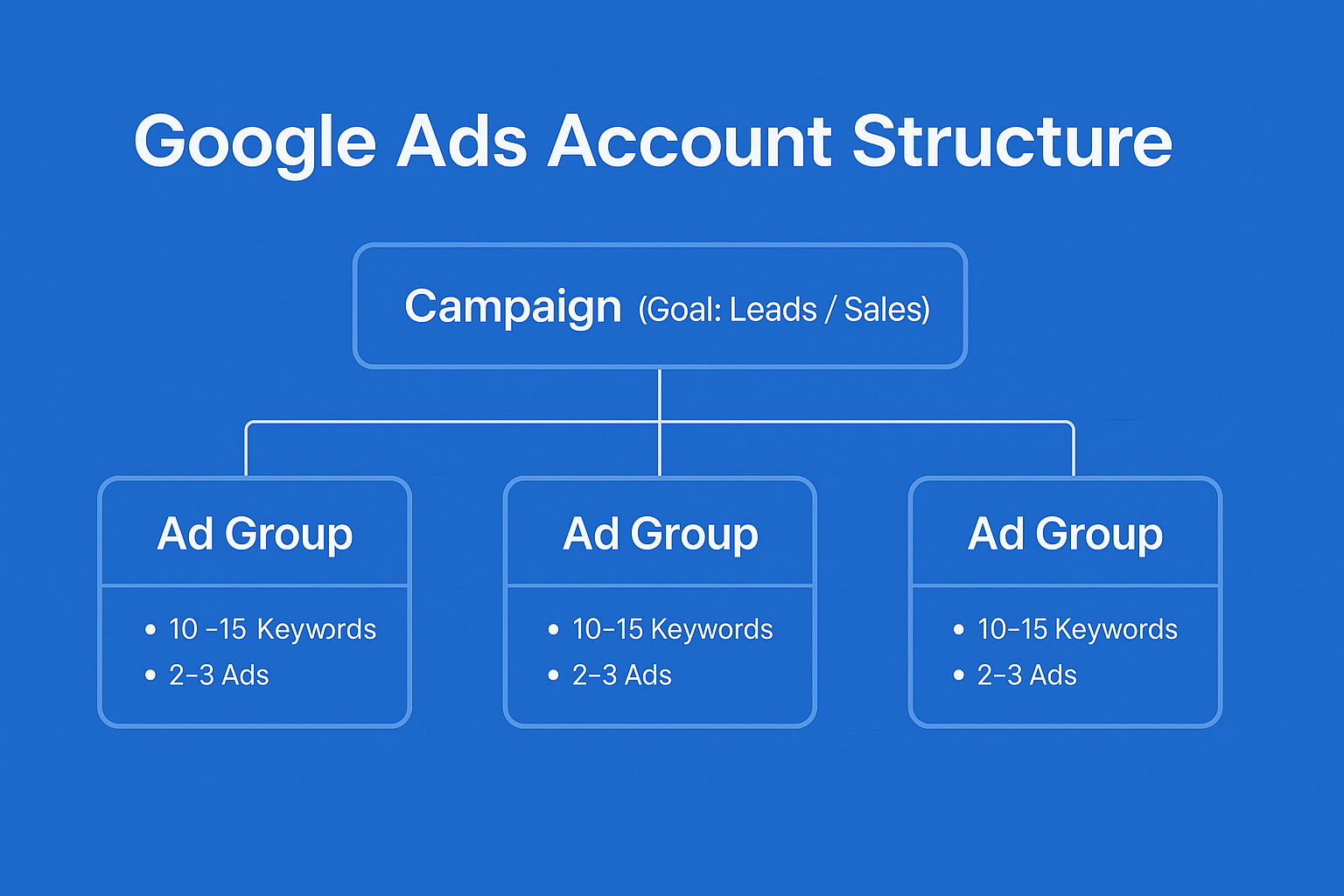Mastering Google Ads: A Beginner’s Roadmap (2025 Guide)
A clear, no-fluff roadmap that shows you **what to learn first**, **what to ignore**, and **how to launch your first profitable Google Ads campaign** without burning your budget.

Why Learn Google Ads in 2025?
If you can run profitable Google Ads, you never stay out of work. It’s one of the few skills that **directly prints money** for businesses: more leads, more calls, more sales.
You don’t need to learn **everything** in Google Ads. You need the **20%** that controls **80%** of performance. That’s what this roadmap focuses on.
The Beginner Roadmap (5 Phases)
Phase 1: Learn the language – metrics, auction, campaign types.
Phase 2: Set up account, structure, and a simple tracking stack.
Phase 3: Build & launch your first Search campaign (single offer).
Phase 4: Read data, fix leaks, and run weekly optimization loops.
Phase 5: Add PMax/remarketing, test new offers, and scale.
Phase 1 Foundations: Learn the Language of Google Ads
Before touching buttons, you need to understand the **words** Google Ads uses. These are the metrics you’ll live with as a media buyer.
Key concepts to understand
- Impressions – how often your ad is shown.
- Clicks – how often someone clicked the ad.
- CTR – Clicks ÷ Impressions (how attractive your ad is).
- CPC – Cost per Click.
- Conversions – valuable actions (lead, purchase, call).
- CPA / CPL – Cost per Acquisition / Lead.
- Quality Score – Google’s relevance score (ad + keyword + landing page).
Simple KPI snapshot example
| Metric | Good for Beginner |
|---|---|
| CTR (Search) | 4–8%+ |
| Conv. Rate (Lead Gen) | 5–15%+ |
| CPC | Depends on niche – watch trend, not just value. |
| CPL | Compare to client’s target, not a global “good” number. |
Phase 2 Account Setup & Structure
Most beginners lose the game before launching, because their structure is chaos. You want a **clean, simple skeleton**:
Basic structure for a beginner
- 1 account → 1 business / domain.
- 1 campaign → 1 main objective (e.g., “Leads – City A”).
- 2–3 ad groups → each tightly themed around a small keyword set.
- 2–3 ads per ad group → testing angles, not random lines.
Don’t start with 7 campaigns and 50 ad groups. Start with **one clean machine** you actually understand.
Essential settings for beginners
- Location: target areas where the business can actually serve.
- Language: usually the same as the website language.
- Networks: for your first Search campaign, **uncheck Display Network**.
- Bidding: start with a simple goal (e.g., “Maximize conversions” with a small test budget).
Phase 3 Build Your First Search Campaign
Your first goal isn’t perfection. It’s **launch → learn → improve**.
Step-by-step (simplified)
- Pick ONE offer (e.g., “Free consultation”, “Flight booking service”, “Solar roof assessment”).
- Choose 5–15 high-intent keywords around that offer.
- Group them into 2–3 ad groups by theme.
- Write 2–3 Responsive Search Ads per ad group.
- Link the right landing page (not the generic homepage, if possible).
- Set a daily budget you’re comfortable losing while learning.
- Double-check settings → Launch.

Phase 4 Tracking & Weekly Optimization
Launching is 30% of the work. The other 70% is learning from the data.
Minimum tracking setup
- GA4 properly linked to Google Ads.
- At least one primary conversion:
- Lead form submitted
- Phone call (using call tracking or Google forwarding)
- Purchase (for e-commerce)
- Test a form and a call yourself – make sure conversions fire.
Weekly optimization checklist
- Check Search Terms → add negatives for irrelevant queries.
- Identify keywords with many clicks but 0 conversions → lower bids or pause.
- Compare ads → keep best CTR/Conversion Rate; test new variations.
- Review locations, devices, and times → cut what clearly wastes money.
Phase 5 Scaling & Next Steps (After You’re Stable)
Once you’re comfortable with Search and have steady conversions, you can start unlocking more of the platform.
What to add next
- Performance Max for incremental volume (once tracking is solid).
- Remarketing to bring back site visitors and form starters.
- More offers (e.g., different services, locations, or packages).
- Better dashboards (Looker Studio) so you see everything in one view.
Beginner Mistakes to Avoid
- Starting with too many campaigns and no clear structure.
- Letting Google auto-create broad, messy keyword lists.
- Sending all traffic to a slow, generic homepage.
- Judging success only on clicks, not leads or sales.
- Making big changes every day instead of weekly, data-driven edits.
Want a Google Ads expert to build this roadmap for you?
AdShot Media is a Google-Partner agency focused on **ROI**, not vanity metrics. We set up, manage, and scale campaigns with transparent dashboards.
FAQs
How long does it take to see results as a beginner?
Usually 2–4 weeks to collect enough data, and 1–3 months to feel confident, depending on your budget, niche, and how aggressively you test.
Do I need a big budget to start learning?
No. You need a budget that’s big enough to generate data. Even ₹800–₹2,000/day (or $10–$30/day) per campaign can be enough for learning if your niche isn’t extremely expensive.
Is Google Ads still worth learning with all the automation?
100%. Automation doesn’t remove the need for strategy. It makes **good strategists more powerful** and makes bad setups fail faster.

AdShot Media is a Google-Partner performance agency running Google Ads for Travel, Solar, Home Services & E-com brands. We care about **profit**, not just clicks.
